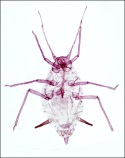Classification
Aphidinae: Aphidini
Common name(s)
Greenbug, wheat aphid
Diagnosis
Apterae small, rather elongate oval, with head and prothorax yellowish or greenish straw-coloured, rest of thorax and abdomen yellowish green to bluish green with a darker spinal stripe. They colonize on upper surface of leaves of grasses and cereals. Their feeding often results in yellowing and other phytotoxic effects. The aphid is found usually in small groups of about 4 to 5 on the upper surface of the leaves along the midrib and is indistinguishable on the leaf. Alatae have a brownish yellow head and prothorax, black thoracic lobes and yellowish-green to dark-green abdomen. In both morphs the siphunculi are pale but usually have darker apices. Alatae have only one-branched media.
Body generally 7.5 times as long as siphunculi, however, in smaller specimens six times longer. Processus terminalis more than 4 times the base of last antennal segment, but smaller in smaller specimens. Both siphunculi and cauda pale coloured.
In Bangalore conditions, the aphid colonized the crop twice during the crop season, with small populations when the crop was young and heavy populations at the earhead stage.
Distribution
Of Palaearctic origin, now widely distributed in several parts of the world. Southern Europe, Middle East, Central Asia, Africa, South and southeast Asia, Australasia, North, Central and South America. Recorded allover South India.
Host plant(s)
Poaceae: Cynodon dactylon (Linn.) Pers., Hordeum vulgare L., Oryza sativa L., Pennisetum glaucum R. Br., Triticum aestivum L., Zea mays L., Eleusine coracana (Linn.) Gaertn.
Measurements
Aptera: Length of body 1.68, width 0.82; antennae 1.52, segments III: IV: V: VI 0.27: 0.16: 0.17: (0.09+0.41); u.r.s. 0.06; h.t.2 0.09; siphunculus 0.21; cauda 0.14.
Alata: Length of body 1.99, width 0.89; antennae 1.89, segments III: IV: V: VI 0.42: 0.24: 0.23: (0.11+0.57); u.r.s. 0.09; h.t.2 0.10; siphunculus 0.23; cauda 0.13.
Seasonal occurrence
June-July and August-September.
Natural enemies
Coleoptera: Coccinellidae: Cheilomenes sexmaculata (F.), Coelophora biplagiata (Swartz), Harmonia dimidiata (F.).
Hymenoptera: Braconidae: Aphidiinae: Aphidius colemani Viereck, Diaeretiella rapae (M'Intosh), Lipolexis gracilis .




